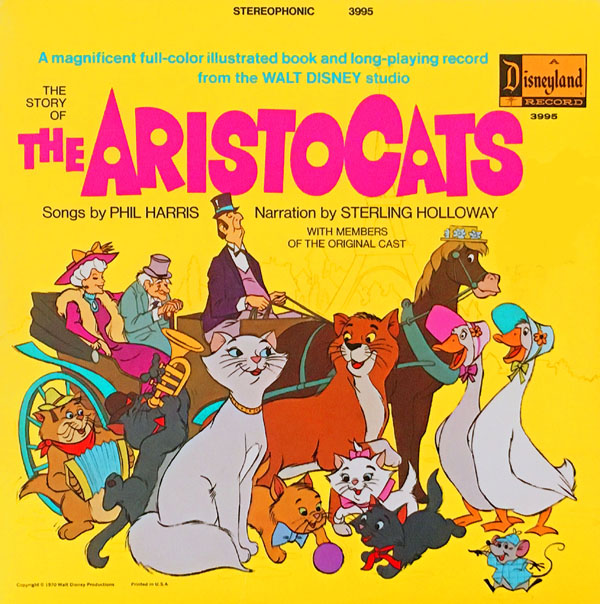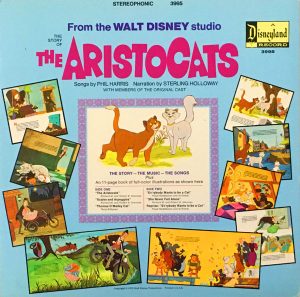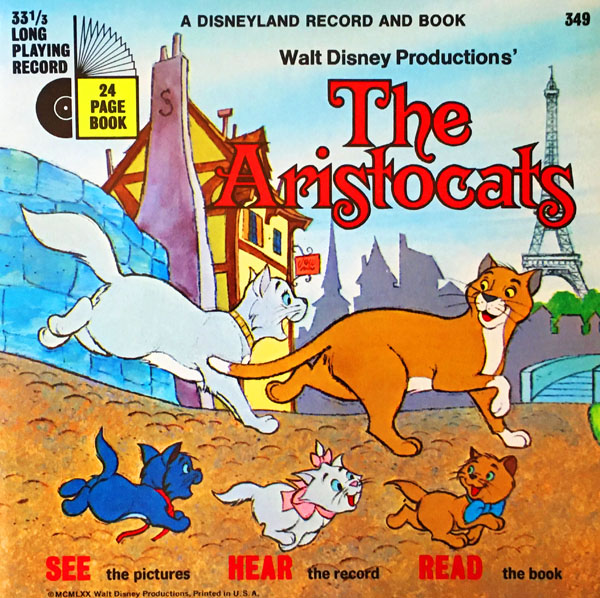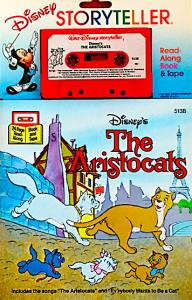The cats with the finest address in Paree made their debut 50 years ago this year, so here’s a look at the Storyteller album that recreated the story of the film on two continents.

From the WALT DISNEY STUDIO
The Story of
THE ARISTOCATS
Disneyland Records – Storyteller Series STER-3995 (12” 33 rpm LP with Book / Stereo & Mono)
Released in August, 1970. Executive Producer: Jimmy Johnson. Producer/Musical Director: Tutti Camarata. Vocal Director: Mike Sammes. Orchestrations: Brian Fahey. Vocal Assistance: Robie Lester. Story: Larry Clemmons, Vance Gerry, Ken Anderson, Frank Thomas, Eric Larson, Julius Svensen, Ralph Wright, from a Story by Tom McGowan, Tom Rowe. Recorded in Hollywood at Sunset Sound Recorders and London at Abbey Road Studios. Running Time: 44 minutes.
Voices: From Film Cast: Sterling Holloway (Roquefort/Narrator); Phil Harris (O’Malley).
From Studio Cast: Robie Lester (Duchess, Toulouse, Frou-Frou, Madame Bonfamille); Susan Novack (Marie); Gregory Novack (Berlioz); Sam Edwards (Edgar); Victor Sweier (Vocalist).
From Soundtrack: Pat Buttram (Napoleon); George Lindsey (Lafayette); Carole Shelley (Amelia Gabble); Monica Evans (Abigail Gabble).
Songs: “The Aristocats,” “Scales and Arpeggios,” “She Never Felt Alone” by Richard M. Sherman, Robert B. Sherman; “Thomas O’Malley Cat” by Terry Gilkyson; “Ev’rybody Wants to Wants to Be A Cat” by Floyd Huddleston, Al Rinker.
 The early seventies were a time of change (time to rearrange) for Disneyland and Buena Vista Records, as an extension of the changes at Walt Disney Productions post-Walt, the record business and what kids and parents were buying and the ever-increasing challenges of time and budget.
The early seventies were a time of change (time to rearrange) for Disneyland and Buena Vista Records, as an extension of the changes at Walt Disney Productions post-Walt, the record business and what kids and parents were buying and the ever-increasing challenges of time and budget.
Unlike the previous Jungle Book storyteller, a smashing success utilizing original soundtrack dialogue, the decision was made to forego using any dialogue from The Aristocats except the slapstick sequence with the two country dogs and the witty sequence between the geese and O’Malley. Obviously based on the “Pigeon sisters” from Neil Simon’s play and movie The Odd Couple, Amelia and Abigail Gabble were voiced by the same actors Monica Evans and Carole Shelley (who went on to be in the original cast of Wicked among many other films and shows). Evans and Shelley returned to Disney to voice Maid Marian and Lady Kluck for 1973’s Robin Hood (please visit this Spin).
Phil Harris’ soundtrack dialogue with the geese was not used. Instead he re-recorded his dialogue and it was added in to Shelley and Evans soundtracks. His knack for vocal timing in his interaction with the studio cast members does, however, sound as if he might have been there with them. Based on the layout of Sunset Sound, Harris could have been in Studio “A” while the other actors were in the isolation booth nearby. There was a window so they could see each other. His voice has a different sound quality, as if he is in a different room. The combo for Harris’ solos may have also been done at Sunset with him and a small combo, with other elements added in London.
 This is the last Disney animated film to be produced by Disneyland Records President Jimmy Johnson and Musical Director Tutti Camarata’s creative and technical group, and to be dramatized with what might be called “The Sunset Players,” the stock company that Tutti and Jimmy assembled over the previous decade when soundtrack dialogue was not cleared for commercial recordings. For this album, they included Robie Lester, Sam Edwards and Sterling Holloway (who was under contract to Disneyland Records for a time). Others included Dal McKennon, Ginny Tyler, Teri York, Thurl Ravenscroft, Bill Lee, Ron Howard, Jimmy Macdonald and Gerry Hoff. The last live-action Disney film to be done by members of this “company” was The Boatniks in the same year. 1971’s Bedknobs and Broomsticks had only a narrator, Dal McKennon.
This is the last Disney animated film to be produced by Disneyland Records President Jimmy Johnson and Musical Director Tutti Camarata’s creative and technical group, and to be dramatized with what might be called “The Sunset Players,” the stock company that Tutti and Jimmy assembled over the previous decade when soundtrack dialogue was not cleared for commercial recordings. For this album, they included Robie Lester, Sam Edwards and Sterling Holloway (who was under contract to Disneyland Records for a time). Others included Dal McKennon, Ginny Tyler, Teri York, Thurl Ravenscroft, Bill Lee, Ron Howard, Jimmy Macdonald and Gerry Hoff. The last live-action Disney film to be done by members of this “company” was The Boatniks in the same year. 1971’s Bedknobs and Broomsticks had only a narrator, Dal McKennon.
Inexplicably, this album is stereophonic even though 99% of it plays in mono. The music was recorded and released in stereo on Disneyland’s “songs-only” LP, Songs from the Aristocats and Other Cat Songs, which we explored in this Spin, but they are not heard on stereo on the Storyteller.
The only stereo section on the whole LP is the scene in which Roquefort the mouse (Holloway) joins the cats in drinking the milk that had been drugged by Edgar the butler. His voice comes from one channel and that is it for the stereo effect. One theory is that mono music tracks were mistakenly delivered to the editor for mixing the story and songs. Between the arrangements, the sound quality and the engineering, the mono sound is quite good, although it’s highly recommended to seek out the Camarata stereo tracks either on the DQ-1333 vinyl LP or the Legacy CD.

Walt Disney Productions’
THE ARISTOCATS
Disneyland Records Little Book & Record LLP-349 (7” 33 rpm LLP with Book / Mono)
Released in September, 1970. Executive Producer: Jimmy Johnson. Producer/Musical Director: Tutti Camarata. Disneyland Story Reader: Lois Lane. Narration Recorded in London at Abbey Road Studios. Running Time: 9 minutes.
The first version of The Aristocats on the little book and record read-along series featured British singer Lois Wilkinson (under her stage name of “Lois Lane,” from the comic book heroine of the same name). Her wonderfully elegant pronunciation of “AAH-ristocats” was of special note. Two songs from the Camarata version appeared on side two.
Walt Disney Productions’
THE ARISTOCATS
Disneyland Records Storyteller Book & Cassette 513-B (Audio Cassette with Book / Mono)
Revised in 1987. Producer: Ted Kryczko. Storyteller: Linda Gary. Music: Disneyland Record Stock Library. Running Time: 10 minutes.
 Disneyland Records was in the midst of change when the second read-along of The Aristocats was made. Read-along and album producer Jymn Magon had moved on to Walt Disney Television Animation with such classics as Disney’s Adventures of the Gummi Bears (see this Spin) and Duck Tales (see this Spin), and one of his successors Bambi Moé was also at WDTVA as an Associate Producer of Music (and later Vice-President). Ted Kryczko has enjoyed the career associated with Walt Disney Records, on staff and freelance. To this day, he produces CD read-alongs for the publishing division, as does longtime Disney records producer and restoration pioneer Randy Thornton.
Disneyland Records was in the midst of change when the second read-along of The Aristocats was made. Read-along and album producer Jymn Magon had moved on to Walt Disney Television Animation with such classics as Disney’s Adventures of the Gummi Bears (see this Spin) and Duck Tales (see this Spin), and one of his successors Bambi Moé was also at WDTVA as an Associate Producer of Music (and later Vice-President). Ted Kryczko has enjoyed the career associated with Walt Disney Records, on staff and freelance. To this day, he produces CD read-alongs for the publishing division, as does longtime Disney records producer and restoration pioneer Randy Thornton.
Most of Disneyland’s post-1977 read-along series featured a full cast, but there were a few exceptions. Two were this title and It’s a Small World, both narrated by Linda Gary (the voice of Maleficent in the Disneyland show Fantasmic!, Queen Marlena on He-Man and the Masters of the Universe, Aunt May on Marvel’s 1994 Spider-Man).
The text was adapted from the 1970 book with music from the Disney read-along music library by such composers as Gary Powell and Jim Andron. The two Camarata versions of “The Aristocats” and “Ev’rybody Wants to Be a Cat” finish out the recording. The original, complete George Bruns score was not yet available for commercial recordings in the United States as yet. Randy Thornton’s Walt Disney Records Legacy Collection soundtrack album was another 18 years away.
By this time, Disneyland/Vista Records, along with most of the children’s record industry had decided to transition completely from seven-inch vinyl 45 and 33 1/3 rpm records to cassettes, following the consumer use of cassettes in their homes and cars. Unless some limited run of Aristocats vinyl LLP and book sets existed somewhere, the cassette seems to have been the only format in which this was available. The following year, all Disney albums would shift from vinyl to CD or cassette (but not forever!)

GIVE A LITTLE LISTEN
The Whimsical World of Charles Lane
Crusty character actor Charles Lane, who passed away at the ripe old age of 101 102 in 2007, is best remembered for his 72-year career playing cranky bureaucrats in everything from It’s a Wonderful Life to I Love Lucy. He was the go-to modern-day Scrooge for countless mid-century TV sitcoms spoofing Dickens’ A Christmas Carol. Few probably remember that he gave a scene-stealing comedy performance for Disney as the voice of Magoo-like lawyer George Hautecourt in The Aristocats. Even fewer realize that he recorded stories for children, like the two following gems that he performed for a Los Angeles company in 1981. If he were here now, one of his more familiar characters might say something like, “Well–get on with it. Watch them! Hurry up, I haven’t got all day.”


 GREG EHRBAR is a freelance writer/producer for television, advertising, books, theme parks and stage. Greg has worked on content for such studios as Disney, Warner and Universal, with some of Hollywood’s biggest stars. His numerous books include Mouse Tracks: The Story of Walt Disney Records (with Tim Hollis). Visit
GREG EHRBAR is a freelance writer/producer for television, advertising, books, theme parks and stage. Greg has worked on content for such studios as Disney, Warner and Universal, with some of Hollywood’s biggest stars. His numerous books include Mouse Tracks: The Story of Walt Disney Records (with Tim Hollis). Visit 





















































The production values on the “Aristocats” storyteller album are noteworthy, particularly considering the time of transition at the Disney Studios. Its running time of 44 minutes is remarkable for an album aimed at children. The recording encompassed much more of the movie than many of its counterpart albums for other Disney films. Coincidentally, I just listened to this recording last week.
I do enjoy Robie Lester’s impersonation of Eva Gabor. It probably fooled a lot of listeners, children and adult alike. This is probably one of the last times that such an impressive cast, including the likes of Phil Harris and Sterling Holloway, was assembled for a re-dramatization of a Disney animated film for records.
I notice you did not mention George Lindsey and Pat Buttram as the dogs Lafayette and Napoleon, who are also on the album. Was their dialogue lifted from the film sound track, or did they re-record their parts for the album?
As for the Lois Lane recording, I also had that Read-a-Long record when the film was released, and it was the first time I had heard of this voice actress. Of course, I knew the character of Lois Lane from the Superman TV series and the comic books, but I thought, especially since this story reader was British, that the name was a coincidence. It didn’t occur to me that her choice of name could have been a deliberate tribute to the “real” Lois Lane. While I enjoyed the Read-a-Long record, it wasn’t on a par with the storyteller album.
You have mentioned previously about the jazzy versions of the Aristocats songs that were heard on the records. I much prefer Phil Harris’ recordings of “Thomas O’ Malley Cat” and “Everybody Wants to be a Cat” that were recorded for Disneyland Records than the original soundtrack versions. Though the film soundtrack used a big band sound, it doesn’t compare to the rich jazz of the records.
Folks,
It was because of Frederick that Goober and Mr. Haney found their rightful place in the article. The omission was such a silly mistake. Désolé!
After all these years, I’m still trying to figure out there could be a Sixties-era hippie cat in 1910.
He was considered a genius in France.
Charles Lane was actually 102 when he passed away. He was born in San Francisco in 1905 and was one of the last remaining survivors of the great earthquake of’06. His last professional gig was when he recorded “The Night Before Christmas” in 2006 at the age of 101. Quite a few beloved character actors of my childhood did voices in The Aristocats!
I can just hear Charles Lane chewing me out right now for my blasted incompetence! And while he was at it, telling Mrs. Bradley that the the Shady Rest had better get its act together and that Mrs. Carmichael ought to learn to manage her budget!
Not to mention prosecuting Tarzan during his New York adventure, and being the only person in Bedford Falls besides George Bailey with the nerve to stand up to Mr. Potter!
Pretty good! I would assume if they did make a vinyl version of the 1987 “Aristocats” read-along, the book probably would’ve been the same 1970 version, complete with identical front and back covers, so you wouldn’t know it was the revised version until you actually played the record! I’m guessing this, since the 1987 read-along used the exact same text as the 1970 version, word for word, presumably because it didn’t have any character dialogue, thus making it easy to just have Linda Gary read the 1970 text.
Most pre-1977 read-alongs have a diagonal line with a red and yellow design, and the very early ones have a big white square with two columns of advertising copy (but those were changed to the diagonal too). Read-alongs from The Rescuers in 1977 onward have a rectangle at the bottom with a yellow background. If there was a 1987 Aristocats read-along on vinyl, it would have had the latter design on the back so unlike some albums which were mysteries until you listened, these were different on the back because the later ones always had background music and sound effects.
Nice subtle reference to the Brady Kids song “Time to Change”!